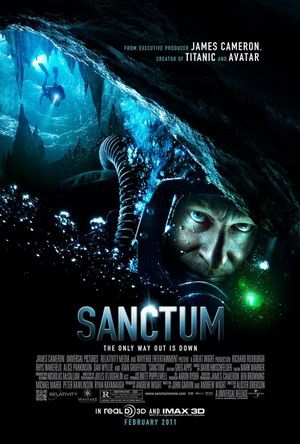 The first and main thing that anyone will bring up about the James Cameron-executive produced Sanctum are the stunning visuals delivered by the vaunted Cameron/Vince Pace 3D Fusion cameras. As wielded by director Alister Grierson (Kokoda) and cinematographer, Jules O’ Loughlin, they make the obvious visually pleasing elements, such as underwater and various cave scenery, spectacular. They also bring ridiculous depth to the ordinary. Everything in the film pops visually and Sanctum, like Avatar and even Resident Evil: Afterlife, which were both shot with the 3D fusion cameras, is more evidence that post production 3D conversion is the increasingly bullshit alternative. That being said, though, everything else about the film, the portrayals and script, range from serviceable to trite and familiar in support of that main feature of the movie.
The first and main thing that anyone will bring up about the James Cameron-executive produced Sanctum are the stunning visuals delivered by the vaunted Cameron/Vince Pace 3D Fusion cameras. As wielded by director Alister Grierson (Kokoda) and cinematographer, Jules O’ Loughlin, they make the obvious visually pleasing elements, such as underwater and various cave scenery, spectacular. They also bring ridiculous depth to the ordinary. Everything in the film pops visually and Sanctum, like Avatar and even Resident Evil: Afterlife, which were both shot with the 3D fusion cameras, is more evidence that post production 3D conversion is the increasingly bullshit alternative. That being said, though, everything else about the film, the portrayals and script, range from serviceable to trite and familiar in support of that main feature of the movie.
Cameron’s influences are evident; and like a shout in the Papua, New Guinea Esa ‘ala caves, where the film is set, Sanctum echoes some elements from his previous films. Much of the tight underwater segments and an impending cyclone recall The Abyss, the sub-surface tranquility recollects Ghosts of the Abyss (which producer/co-writer Andrew Wight worked on with Cameron), and there’s even an adventure primer courtesy of a computer-generated map of the cave system ala Titanic. While the setting is The Descent (sans the C.H.U.D. types), the action is very much The Poseidon Adventure, complete with the creeping waterline and the hardass protagonist. Although based on Wight’s own personal experience in a similar situation, the film nevertheless becomes a formulaic adventure struggle that makes use of recognizable characters in a familiar group dynamic.
The aforementioned hardass is cave explorer, Frank McGuire, gamely portrayed by Richard Roxburgh. Frank readily admits that the only place he’s any good is underground, where he repeatedly drags his resentful moppet offspring, Josh, portrayed by young Aussie, Rhys Wakefield (The Black Balloon). Frank is about the mission and the mission only and rarely betrays anything, even when a close colleague tries to grow gills and fails. Frank is tasked by financier windbag and friend, Carl (Ioan Gruffudd), a Richard Branson type with better grooming habits, to map the route of the massive cave system to the sea. Predictably, the mission is overdue and overbudget, and Carl shows up Down Under to oversee a final push and generally cause everyone grief. Tagging along is his girlfriend, Victoria (Alice Parkinson), an experienced climber but an inexperienced diver, which will predictably translate into underwater misadventures later on. Frank’s own personal Catfish de Vries, aptly named Crazy George (Dan Wyllie), rounds out the main cast.
As one would expect, the cyclone invites itself to the party much sooner than predicted and generally ruins everyone’s day. A flash flood seals off the entrance to the caves and Frank and company face having to go deeper into the unexplored sections of the cave system in order to avoid becoming future archaeological finds. The struggle for survival is frequently exacerbated by the various relationship difficulties and personality clashes. The film has really nothing distinctive to offer in this regard, as there’s the expected differences of opinion on who’s in charge, resentments, foolish choices regarding wardrobe and to whose advice to listen during a crisis situation, as well as a mandatory betrayal. Still, as boilerplate as the character relationships are, the central arc between Frank and Josh isn’t unaffecting and does give Sanctum a good enough of an anchor on which to hang everything else. Portrayals all around are generally up to the task as written, although most are unremarkable.
The cave presents a series of dangers that are nicely captured by Grierson, from tight underwater spaces, to a cavernous “cathedral” setting, to an underground geyser. Grierson does pace the film at an appropriate clip, giving ample time to production designer Nicholas McCallum’s sets, which instill equal moments of tranquility and claustrophobia, without having the film drag. As mentioned, the 3D is used in the manner it should be, to highlight rather than detract from the story, and frequently looks amazing. Also, something that shouldn’t be overlooked is sound designer Paul Pirola’s work. There are a couple of distinctive moments, such as the cracking of one character’s head against a cave wall, and a couple of perforated characters’ girgling death gasps that had the audience squirming.
This isn’t a James Cameron film, but his fingerprints are definitely on it. Attention to detail and technical proficiency regarding cave diving and spelunking are well on display here. So thankfully, one need not shut down one’s brain in order to enjoy Sanctum; rather merely accept that, first and foremost, it’s a visual showcase draped around well-worn and oft-seen adventure premises and characters. Particularly if one is a connoisseur of James Cameron films.
Rating: 




Out of a Possible 5 Stars